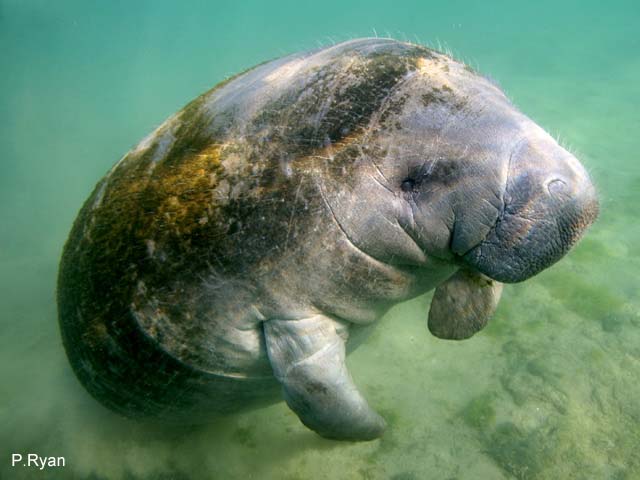| Trichechidae () |
| 390 cm TL (male/unsexed); max.weight: 1,590 kg |
|
demersal; freshwater; brackish; marine; depth range 0 - 13 m |
| Western Atlantic: Trichechus manatus manatus: from the coasts and rivers of Mexico to as far south to Rio Doce, Brazil including the Orinoco and Amazon; Trichechus manatus latirostris: from the Florida Peninsula to Rhode Island. Tropical to temperate. |
|
|
| Found in coastal marine, brackish and freshwater areas. Feeds on aquatic plants, (i.e. water hyacinths and marine seagrasses, algae, parts of mangrove trees, floating and shoreline vegetation); invertebrates (i.e. tunicates); and fish they remove from fishing nets (Ref. 1394). Found in coastal marine, brackish and freshwater areas (Ref. 1394), where primary habitat consists of rivers, coastal lagoons and bays and mangrove islands (Ref. 86755). Feeds on aquatic plants, (i.e. water hyacinths and marine seagrasses, algae, parts of mangrove trees, floating and shoreline vegetation); invertebrates (i.e. tunicates); and fish they remove from fishing nets (Ref. 1394). |
|
Vulnerable (VU); Date assessed: 30 June 2008 (C1) Ref. 123251)
|
|
|
Primary habitats are in rivers, coastal lagoons and bays, and mangrove islands between the Belize Barrier Reef and mainland (Ref. 86755). It is also known from Glover's Reef Atoll (Ref. 85586). At Basil Jones, they are present during the rainy season (June to November), absent from December to March, and returns at the end of the dry season (April and May). They stay in calm, deep waters of the channel inside the reef crest where resting and socializing behavior was observed. In Gallows Reef, they are observed to be present during the summer season. Their group size has an observed increase in late July and August. In the Drowned Cayes area, they were observed feeding, socializing, resting and nursing calves (Ref. 87094). Varied seasonal distribution and movement along the Belize Barrier Reef is related to seasonal changes in water temperature, salinity, depth, or sex-specific differences in reproductive activity. Access to freshwater is also a directive factor influencing the seasonal use of the reef in the Belize coastal zone (Ref. 86755). Extending from the Gulf of Honduras in the south of Chetumal Bay in the north, Belize reports the largest number of Antillean manatees in the Caribbean region (Ref. 87025). C: Ref. 85586, 86755, 87094; M: Ref. 1394; O: Ref. 86755. |
Source and more info: www.sealifebase.org. For personal, classroom, and other internal use only. Not for publication.

